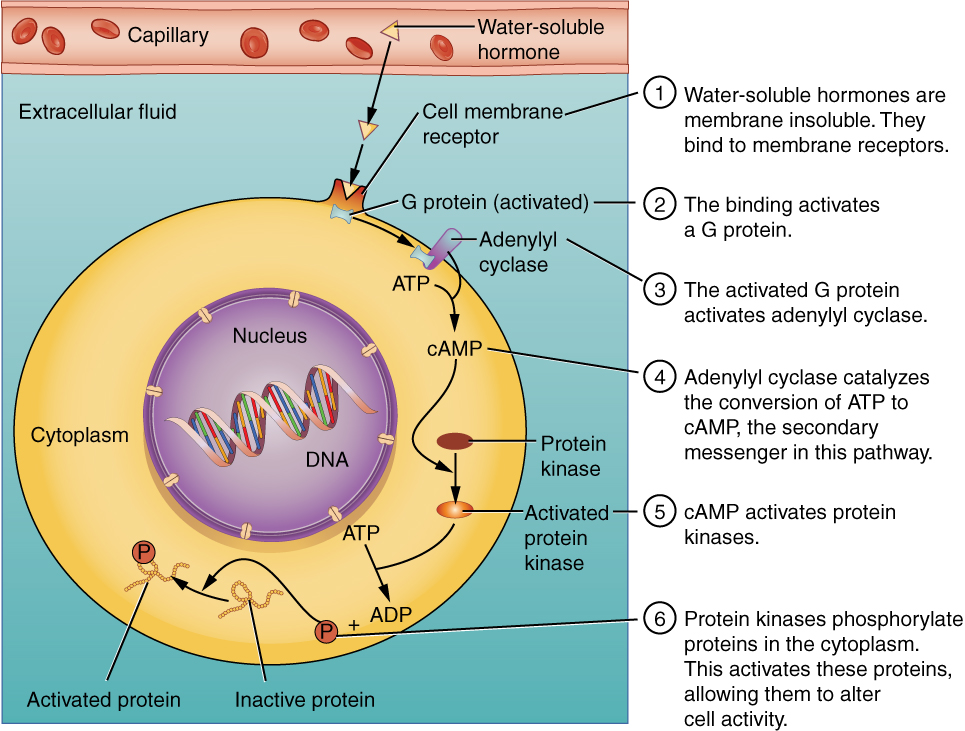Steroid Hormones are Water-soluble since they are lipid-soluble and derived from cholesterol. They consist of four carbon rings with different side chains.
Steroid hormones are a group of hormones that are derived from cholesterol. Because they are relatively hydrophobic, steroid hormones are lipid soluble and can easily dissolve in fats and oils. Unlike water-soluble hormones that dissolve quickly, steroid hormones cannot dissolve in water-based solutions.
Due to their chemical properties, steroid hormones can pass through the cellular membranes to reach their target cells. Once inside the cell, steroid hormones bind to receptor proteins in the cytoplasm or the cell’s nucleus. Because of their ubiquitous characteristics in the body, steroid hormones are involved in various physiological processes. They play crucial roles in controlling metabolism, growth, reproduction, stress response, and immune function.

Credit: pressbooks.claremont.edu
What Are Steroid Hormones?
Steroid hormones like testosterone and estrogen are not water-soluble and are derived from cholesterol with different side chains. In contrast, water-soluble hormones, including insulin and adrenaline, bind to receptor proteins on the plasma membrane and dissolve in water.
Steroid hormones are a type of hormone that are derived from cholesterol and are lipid-soluble. This means they are not soluble in water and require a carrier protein to transport them through the bloodstream. Steroid hormones have a unique chemical structure that consists of four carbon rings with different side chains. So, what are steroid hormones’ properties and their chemical structure?
Chemical Structure Of Steroid Hormones
The chemical structure of steroid hormones is characterized by four carbon rings with different side chains made from carbon, hydrogen, and oxygen atoms. The arrangement of these atoms in the rings and side chains determines the specific steroid hormone produced. For example, testosterone, a male sex hormone, has a different side chain than estrogen, a female sex hormone. This gives each hormone its unique properties and functions.
Properties Of Steroid Hormones
Steroid hormones are lipid-soluble and can easily pass through cell membranes, allowing them to bind to receptors inside the cell. They are also characterized by slow and long-lasting effects that persist for several hours or even days. Steroid hormones are responsible for many physiological processes, such as regulating metabolism, immune response, and reproductive functions. They are also involved in developing secondary sexual characteristics, such as facial hair and muscle mass. In conclusion, steroid hormones are a type of hormone that are derived from cholesterol and are lipid-soluble. Their unique chemical structure consists of four carbon rings with different side chains, and they have slow and long-lasting effects. By knowing steroid hormones’ chemical structure and properties, we can better understand their role in the body’s functions.

Credit: www.healthline.com
Solubility Of Steroid Hormones
Steroid hormones are slightly soluble in water and are derived from cholesterol, composed of four carbon rings with different side chains. However, they are considered lipid-soluble and not water-soluble like other hormone types, such as water-soluble hormones that bind to receptor proteins in plasma membranes.
###Solubility of steroid hormones### Steroid hormones are biological compounds that act as signaling molecules in our body. They regulate various physiological processes like metabolism, growth, and reproduction. One of the essential properties of steroid hormones is their solubility. Solubility refers to the ability of a substance to dissolve in a particular solvent. Steroid hormones have unique solubility characteristics crucial in their action and transport within the body. Two types of solubility hormone molecules can possess: water-soluble and fat-soluble. In this section, we will focus on the solubility of steroid hormones and how they affect their functions. #####Types of Solubility##### There are two primary types of solubility: water solubility and fat solubility. Water-soluble hormones like insulin dissolve in water and cannot pass through the cell membrane.
In contrast, fat-soluble hormones, such as steroid hormones, can pass through the cell membrane because they dissolve in fat. The solubility characteristics of hormones are essential because they affect how hormones interact with cells and tissues. #####Explanation of Water Solubility##### Steroid hormones are fat-soluble molecules that can only interact with target cells that contain appropriate receptors.
However, some steroid hormones have unique properties that make them water-soluble. For example, cortisol and aldosterone have polar functional groups, which allows them to dissolve partially in water. The solubility characteristics of steroid hormones determine how they bind and activate receptors on the cell surface. Once activated, the receptor-hormone complex initiates a series of signal transduction pathways, ultimately leading to the physiological response. #####Comparison with Fat Solubility##### The fat solubility of steroid hormones plays a crucial role in their action and transport within the body. Fat-soluble hormones can pass through the cell membrane and bind to specific receptors within the nucleus or cytoplasm of the target cell. Once bound, the hormone-receptor complex acts as a transcription factor and activates target genes, leading to changes in protein synthesis. The fat solubility of steroid hormones also affects their transport within the body. Since they are lipid-soluble, they can diffuse across cell membranes and enter the bloodstream without the need for specific transport proteins. In summary, the solubility characteristics of steroid hormones play a critical role in their biological action and transport within the body. Understanding how hormone molecules interact with cells and tissues is essential for developing therapies and treatments for various diseases and disorders.
How Do Water-soluble Steroid Hormones Function?
Contrary to popular belief, steroid hormones are water-soluble. They bind to receptors located on the plasma membrane, triggering a cascade of reactions within the cell. Unlike lipid-soluble hormones, they cannot diffuse through the cell membrane.
How do water-soluble steroid hormones function? Water-soluble steroid hormones can dissolve in water and are vital endocrine system components. These hormones include compounds derived from cholesterol, such as estrogens, androgens, and glucocorticoids. Understanding how these hormones function is essential in comprehending the regulation of the body’s processes and how it responds to changes. Transport in the bloodstream: Water-soluble hormone molecules are transported through the bloodstream by binding proteins that carry them to their target cells. The proteins help to prevent the molecules from being degraded or filtered out by the kidneys. Once the hormones reach their target cells, they bind to specific receptor proteins on the cell membrane surface. Interaction with cell surface receptors: The binding of the hormones to the receptor proteins on the cell surface initiates a signaling cascade that affects the activity of various enzymes and other proteins in the cell. As a result, cellular processes such as protein synthesis, gene transcription, and ion transport are altered. Activation of second messenger systems Water-soluble steroid hormone receptors are membrane proteins coupled with other proteins that activate second messenger systems. The second messenger molecules inside the cell, such as cyclic AMP and calcium ions, trigger a cascade of events that ultimately lead to the desired cellular response. This signaling mode is an essential regulatory mechanism for the body as it enables signals to be processed at the cellular level and allows for rapid responses to environmental changes. In conclusion, understanding the basic mechanisms by which water-soluble steroid hormones function is crucial in comprehending how the body regulates its processes. These hormones play essential roles in many aspects of the body, such as growth and development, metabolism, and stress response.

Credit: www.healthline.com
Examples Of Water-soluble Steroid Hormones
HTML:
Steroid hormones are a class of hormones that are derived from cholesterol. They are lipid-soluble, but some steroid hormones are water-soluble as well. The water-soluble hormones can dissolve in water due to polar functional groups in their structure. Let’s take a look at some examples of water-soluble steroid hormones:
Cortisol
Cortisol is a glucocorticoid hormone that is produced in the adrenal cortex. It plays a crucial role in regulating the body’s response to stress and helps maintain blood sugar levels. Cortisol is synthesized from cholesterol and is a water-soluble steroid hormone. It binds to a receptor protein located on the cell’s plasma membrane, where it initiates a signaling cascade that leads to its physiological effects.
Aldosterone
Aldosterone is a mineralocorticoid hormone that is produced in the adrenal cortex. It regulates electrolyte balance in the body, particularly sodium and potassium ions. Aldosterone is synthesized from cholesterol and is a water-soluble steroid hormone. It binds to a receptor protein located on the cell’s plasma membrane, where it initiates a signaling cascade that leads to its physiological effects.
Testosterone
Testosterone is a hormone primarily produced in the testes of males but also in the adrenal cortex of both males and females. It is responsible for the development of male secondary sexual characteristics such as deepening of the voice, growth of facial hair, and muscle mass. Testosterone is synthesized from cholesterol and is a water-soluble steroid hormone. It binds to a receptor protein located on the cell’s plasma membrane, where it initiates a signaling cascade that leads to its physiological effects.
Estrogen
Estrogen is a group of female sex hormones that are produced mainly in the ovaries but are also produced in the adrenal glands and fat tissues. It is responsible for developing female sexual characteristics such as the growth of breasts, the distribution of body fat, and the regulation of the menstrual cycle. Estrogen is synthesized from cholesterol and is a water-soluble steroid hormone. It binds to a receptor protein located on the cell’s plasma membrane, where it initiates a signaling cascade that leads to its physiological effects.
Effects Of Steroid Hormones On The Body
Steroid hormones are derived from cholesterol and are characterized by being lipid-soluble. Unlike water-soluble hormones, which bind to receptors on the plasma membrane, steroid hormones can diffuse through the cell membrane and bind to receptors inside the cell, directly affecting gene expression.
Regulation Of Metabolism
Steroid hormones are crucial in regulating metabolism, which is how our bodies convert food into energy. Specifically, these hormones can affect the metabolism of carbohydrates, proteins, and fats, influencing the production and storage of these molecules in our cells. For example, the adrenal glands’ steroid hormone cortisol helps regulate glucose metabolism, ensuring that our cells have access to the fuel they need to function correctly. Other steroid hormones, such as testosterone, have been shown to influence metabolic rate, helping to increase the body’s energy expenditure and encouraging the growth and repair of muscle tissue.
Maintenance Of Salt And Water Balance
Another essential function of steroid hormones is maintaining salt and water balance in the body. Many of these hormones affect the kidneys, helping to regulate the amount of sodium, potassium, and water excreted in the urine. For example, aldosterone, a steroid hormone produced by the adrenal gland, helps to promote sodium reabsorption and potassium excretion in the kidneys, regulating blood pressure and fluid balance.
Development Of Sexual Characteristics
Perhaps the most well-known effects of steroid hormones on the body are their roles in the development of sexual characteristics. Testosterone, for instance, is responsible for developing male sexual traits such as increased muscle mass, facial and body hair growth, and deepening of the voice. Estrogen, on the other hand, plays a critical role in the development of female reproductive organs and secondary sexual characteristics, such as breast development. Without proper levels of these and other steroid hormones, the body may experience developmental and other health problems. Now that we have a clearer understanding of the essential functions of steroid hormones in the body, it’s clear that these molecules play a vital role in maintaining our health and well-being. Whether we’re looking to regulate our metabolism, maintain proper salt and water balance, or develop typical sexual characteristics, steroid hormones are critical to our overall hormonal balance.
Frequently Asked Questions On Steroid Hormones Are Water Soluble.
Which Hormone Is Water Soluble?
Steroid hormones are water-soluble.
Are Steroids Fat Or Water Soluble?
Steroid hormones are water-soluble. They are derived from cholesterol and have a complex structure of four carbon rings with different side chains. Unlike water-soluble hormones, steroids are slightly soluble in water but not soluble in lipids. Steroids perform their actions by minimizing inflammation and reducing immunity.
Water-soluble hormones act by binding to a receptor protein in the plasma membrane.
Are Hormones Fat Or Water Soluble?
Steroid hormones are fat-soluble.
Are Peptide Hormones Water Soluble?
Peptide hormones are generally water-soluble as they contain amino acids and can dissolve in the blood plasma. Unlike lipid-soluble steroid hormones, peptide hormones bind to receptors located on the outer surface of the plasma membrane and trigger a series of molecular events inside the cell.
Conclusion
Steroid hormones are water soluble to a certain extent, but they are primarily lipid soluble given their composition and origin from cholesterol. Water-soluble hormones, on the other hand, bind to receptors on the plasma membrane and are not soluble in lipids.
Understanding the difference between steroid and water-soluble hormones is crucial in understanding their mechanisms of action and how they affect the body. Hopefully, this article has provided valuable insights into this critical topic.






